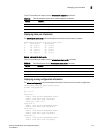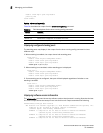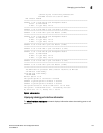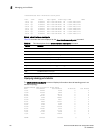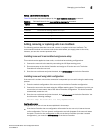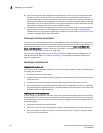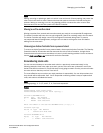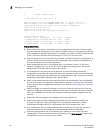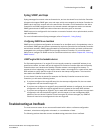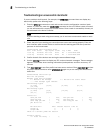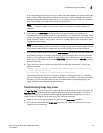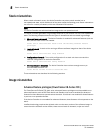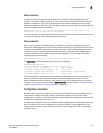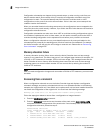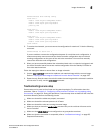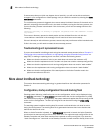
PowerConnect B-Series FCX Configuration Guide 151
53-1002266-01
Troubleshooting an IronStack
5
Syslog, SNMP, and traps
Syslog messages from stack units are forwarded to, and can be viewed from, the Active Controller.
All stack units support SNMP gets, sets, and traps, which are managed by the Active Controller. An
SNMP trap is sent from a stack unit to the stack Active Controller, and forwarded from the Active
Controller to an SNMP-configured server. An external network management station can execute
SNMP gets and sets for MIBs and collect information about any port on the stack.
SNMP traps can be configured for the insertion or removal of a stack unit or uplink module, and for
optic identification.
For more information about Syslog messages, refer to Chapter 41, “Using Syslog”.
Configuring SNMP for an IronStack
SNMP server and feature configuration is the same for an IronStack as it is for standalone units. In
an IronStack, SNMP gets and sets are processed by the Active Controller for the Standby Controller
and all stack members. SNMP traps generated by the Standby Controller and stack members are
propagated to the configured SNMP server through the Active Controller. For more information
about how to configure an SNMP server for PowerConnect devices, refer to Chapter 40, “Securing
SNMP Access”.
SNMP engine IDs for stackable devices
For Dell stacking devices, if an engine ID is not manually created or a stack MAC address is not
specified and saved, the stack will lose its engine ID if the Active Controller fails and the Standby
Controller takes over, because the Standby Controller creates a new engine ID at bootup. To
prevent this from happening, you will need to either create a new engine ID or create a new stack
MAC address to ensure that the engine ID is saved to the startup configuration. This should be
done before the SNMPv3 user is created.
If a new Active Controller is elected (for example, the Standby Controller becomes the Active
Controller) you will see the following results:
• If you have configured the engineID saved it to the startup configuration file, the new stack
configuration will use the saved engine ID.
• If you have not configured an engineID, but a stack MAC address is configured, the new stack
configuration will retain the original engineID since it is based on the stack MAC address.
• If you have not configured an engineID, and no stack MAC address is configured, the new stack
configuration will use the default engineID, which is based on its own management MAC
address of the new Active Controller. Since the engine ID will have changed, any SNMPv3
Clients will need to be reconfigured with the new engineID.
Troubleshooting an IronStack
The most common reason for an unsuccessful stack build is either a software configuration
mismatch, a hardware configuration mismatch, or a combination of both.
The following sections describe common troubleshooting procedures for an IronStack.



